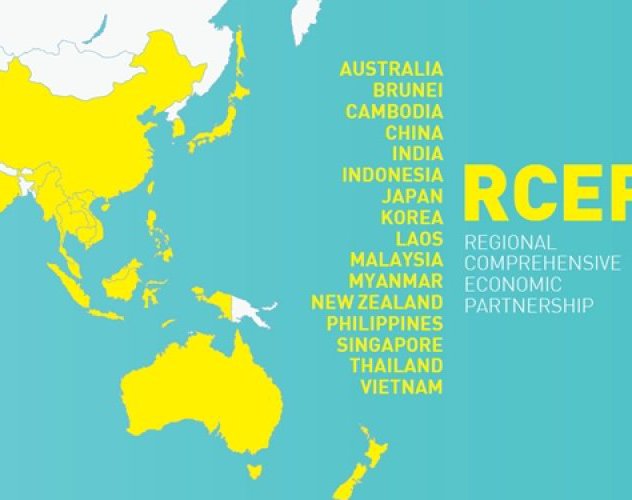The Regional Comprehensive Economic Partnership, which has just entered into force for almost all of its 15 members, accounts for 1/3 of the world’s population, the SCMP argues. More than 90% percent of trade in goods between RCEP members will eventually be subject to zero tariffs under the new trade bloc. As of now, tariffs on more than 65% of China’s trade in goods with the ASEAN area, Australia and New Zealand are expected to reach zero under the RCEP agreement.
The Regional Comprehensive Economic Partnership (RCEP), which went into effect on Saturday, January 1, has 15 members, including China, Japan, South Korea and many other Asian countries, but does not include the United States or India. It is the world’s largest free trade area, within which China expects to cushion the impact of the coronavirus, while promoting growth in the face of “unprecedented” trade challenges during the coming year.
Tariffs on more than 65 percent of China’s trade in goods with ASEAN, Australia and New Zealand are expected to immediately reach zero under the regional agreement.
“[Its entry into force] effectively protects against the negative economic impacts of Covid-19,” Ren Hongbin, Deputy Trade Minister, said at a press conference.
Beijing also said the deal will serve as a “powerful lever” to keep trade and foreign investment stable in 2022, as it will expand exports of Chinese products and help accelerate China’s industrial transformation.
Ren added that China is ready to fulfill 701 binding obligations under the trade agreement, with its implementation marking a new milestone in China’s opening-up.
Although it was the 10-member Association of Southeast Asian Nations that initiated the partnership, Beijing has been seen playing an increasingly active role. Chinese decision-makers intensified their focus on the regional trade deal as they were mired in rising tensions with Washington and its allies, compounded by the coronavirus shock.
The ministry said the deal will gradually reduce tariffs on Chinese imports from ASEAN countries.
Under the aegis of the RCEP agreement, China also reached its first free trade agreement with Japan, which is the world’s third-largest economy and China’s fourth-largest trading partner.
“The two sides will substantially reduce tariffs in many areas, such as machinery and equipment, electronic information, chemical industry, textiles, leathers and so on. In particular, 57% of Chinese exports to Japan next year will immediately reach zero duty, which will obviously promote trade,” said Yu Benlin, head of international economic and trade affairs at the Ministry of Commerce.
He also said that the RCEP agreement will increase investment opportunities between China and other member states, as it introduces wider access for foreign investors and increases the transparency of trade policies.
But Ren nevertheless warned that stabilizing trade in the coming year will be more difficult than ever.
Beijing has stepped up its efforts to protect transnational value chains in 2022 from the effects of the prolonged covid-19 pandemic, even though its export machine has continued to churn out goods for the past 12 months.
In an interview published by the Economic Daily, Commerce Minister Wang Wentao said that the “triple pressure” – contraction in demand, supply shocks and weakening expectations – will be most evident in trade during 2022.
At a meeting of the State Council, the Chinese government announced that more policies would be implemented to help importers and exporters, warning that “the uncertainties, instability and imbalance facing trade are currently increasing.”
Ren expected that the total value of Chinese exports and imports would exceed $6 trillion this year – more than 20% more than in 2020 – further cementing China’s status as the world’s top exporter/importer.
However, year-end difficulties risk compromising 2022 as well, Ren warned, noting that the Omicron coronavirus variant and a growing gap between developed and low-income nations could also have a negative impact on Chinese trade.
“The supply chain bottleneck is difficult to completely alleviate... port congestion continues, the risk of partial disruptions in the supply chain is increasing, raw material and transport costs remain high, and shortages of some raw materials, containers and labor persist,” he added. .
Li Xingqian, head of trade at the Ministry of Commerce, also said that the Chinese authorities will pay more attention to trade and cooperation with trading partners through bilateral and multilateral mechanisms.
The size of the RCEP agreement.
Imports and exports between China and the other 14 members of the RCEP totaled 10.96 trillion yuan ($1.72 trillion) in the first 11 months of this year, accounting for 31 percent of China’s total foreign trade value, according to Chinese customs data.
The RCEP agreement has entered into force for now in Australia, Brunei, Cambodia, China, Japan, Laos, Singapore, Thailand, Vietnam and New Zealand, but will also officially enter into force in South Korea on February 1.
Indonesia, Malaysia and the Philippines are expected to ratify it soon. Burma, whose government was overthrown by the military on 1 February 2021, has ratified it, but this ratification has not yet been accepted by the other members.
The RCEP agreement was originally intended to include about 3.6 billion people. Without India, which has withdrawn, it still covers more than 2 billion people and almost a third of all world trade.
Comparison with other free trade agreements.
The US-Mexico-Canada Agreement, or Mexico-FTA, a reworked version of the North American Free Trade Agreement under Donald Trump, covers a little less economic activity than the RCEP, but less than a tenth of the world’s population.
The EU and the Comprehensive and Progressive Trans-Pacific Partnership (CPTPP), a revised version of a deal rejected by former President Donald Trump, are also smaller. The RCEP includes six of the 11 remaining members of the Trans-Pacific Partnership Agreement, which includes Australia, Brunei, Canada, Chile, Japan, Malaysia, Mexico, New Zealand, Peru, Singapore and Vietnam.
Like any trade deal, the RCEP has its critics.
In a recent legislative hearing broadcast on YouTube, Indonesian government officials urged lawmakers to approve the RCEP. But Elly Rachmat Yasin, a member of a committee responsible for agriculture, environment, forests and the sea, questioned Indonesian Trade Minister Muhammad Lutfi about the wisdom of Indonesia’s involvement in the deal, noting that India withdrew largely over fear that Chinese imports would invade its markets.
Muhammad Lutfi responded that the RCEP will help stimulate exports and attract up to $1.7 billion in additional foreign investment by 2040.
Philippine Trade Secretary Ramon Lopez says he expects lawmakers to ratify the pact in January, after running out of time to do so in December, when the government was busy dealing with the aftermath of a typhoon that hit the country on Dec. 16. About 375 people have died and hundreds of thousands more are still homeless.
The free trading area is expected to create many jobs in the service sector, a major attraction for a country like the Philippines, which relies heavily on foreign remittances.



